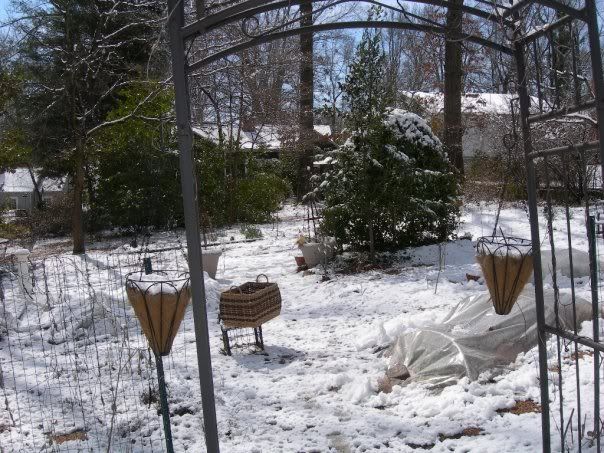How to Get Over “August Slump” and Grow Through the Winter

Photo Caption: When the summer vegetables start to wind down, pull them in favor of fall and winter crops. Remember that summer vegetables are greedy, so your soil will likely need some nutrient adjustments. I used my homemade fertilizer blends for leaf and root vegetables as well as some fresh compost.
Many gardeners hit the tail end of summer at a drag. For some, it is irrigation, weeds, and disease that have taken a toll on their enthusiasm. Others feel they will pave the garden over with concrete before they have to find a use for one more tomato, zucchini, or cucumber!
This year my August Slump was due to increasing shade. I’m not sure if the large oaks in my neighbors’ yards simply managed to grow enough to block more sun, or if the shortening days were the culprit. At any rate, my garden’s sunlight dwindled and vegetable production slackened.
Fortunately, this problem is temporary if the offending trees on your lot are deciduous. Many people who cannot grow vegetables in their summer shade can grow winter vegetables when the trees lose their leaves.
Not that you’ll have February tomato plants (unless you have a hothouse). But it is easy and economical to construct simple, low polytunnels and grow cold season crops to extend your harvest throughout the winter.
By cold season crops I mean the obvious candidates like loose leaf cabbage, kale, radishes, and turnips. But with polytunnels creating the microclimate you can also grow more freeze-tender crops like celery, lettuce, and mache. Other options include spinach, beets, chard, broccoli raab, collards, bok choi, carrots, parsnips, bunching onions, endive, radicchio, and some herbs like cilantro and parsley.
If you managed to set out transplants of heading cabbage, broccoli, and cauliflower in September, you can also overwinter them under polytunnels beautifully. They are harder to grow if you direct-seed late in October.
Some well-established crops are freeze-hardy without polytunnels but are more delicate while they are young. Kale, celery, parsley, and mache are examples of plants that can tolerant harsh weather if they are large before the freezes set in. Otherwise, a polytunnel is required for success. Also, crops overwintering without protection may survive, but they are unlikely to grow until the weather starts to warm back up. For fast growth a warmer environment is required.
The first thing to do is plant your seeds in the fall while warm days are still happening. I’ve found that direct-sowing under my polytunnels during the coldest months yields mixed results. Consequently, I like to plant my winter seeds in late September – early November. Soil still radiating warmth from the summer heat goes a long way in hastening seed germination. But you could start your seeds as late as December if you watch the weather report and plant ahead of an unseasonably warm week.
If you miss the fall and early winter direct-sowing season, you can start transplants indoors where the warmer temps speed germination and then then set your transplants directly into your polytunnels.

Photo Caption: Newly emerged turnip seedlings (and the neighbor's dog's footprints). I plant my fall seedlings thickly and then thin them later. That way if critters decide to eat a few newly emerged plants, I still have plenty that make it to maturity. In many cases I eat the thinned plants as salad toppings.
The next step is to have your polytunnels ready to go. This is not a complicated process. To build a successful polytunnel you need UV resistant plastic film and some sort of support to put it over your beds. Last season my mother and I ordered a roll of plastic film and used flimsy PVC pipe we could bend into hoops as the support. We weighed the edges of the plastic hoops down with rocks and logs. It wasn’t pretty, but we were harvesting spinach all season long.

Photo Caption: Our makeshift polytunnels for the winter 2008 - 2009 season worked great, even though they were a little low and not very decorative.
In the late fall, early winter you simply need to watch out for freezes and cover your seedlings whenever you feel they are in danger. Later in the season you should cover your crops when temperatures are going to be under 50 F and open the covers when temps will be above 50 F. It is important to keep up with this so you don’t freeze or fry your plants. Don’t forget to irrigate!
After that, the only thing to do is to harvest… and to feel smug while you eat fresh garden salads and stir-fries in the middle of winter.
4 thoughts on “How to Get Over “August Slump” and Grow Through the Winter”
Comments are closed.

Tina - January 26, 2010 12:00 pm
Eliza, are brussel sprouts able to survive a freeze or would they need the tunnel too? Love the site BTW!
Sustainahillbilly
Twitter: appalachianfeet
- January 28, 2010 5:34 pm
They might survive the winter, but they’d do much better with a tunnel. Thanks!
Pingback: How to Finish the Fall Garden | Appalachian Feet
Pingback: How to Find Great Plants #2 | Appalachian Feet